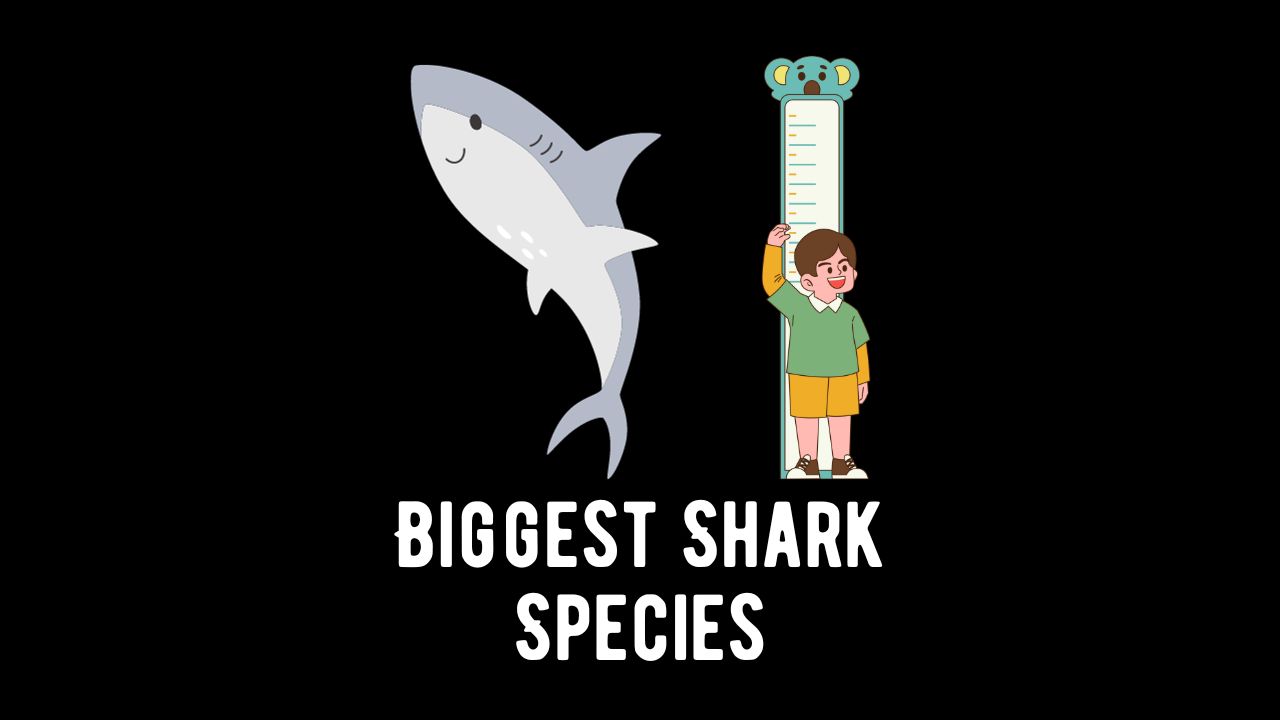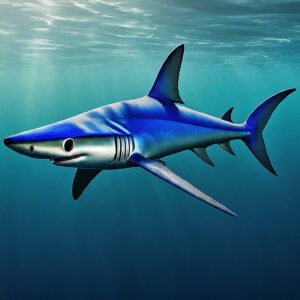
The Giants of the Deep: Exploring the Biggest Shark Species
Sharks, the apex predators of the ocean, come in a diverse range of sizes, from the small and elusive to the massive and awe-inspiring. In this comprehensive exploration, we will delve into the world of the biggest shark species, examining their characteristics, habitats, and the crucial roles they play in marine ecosystems.
1. Whale Shark (Rhincodon typus)
Overview:
- Size:
- Maximum Length: Approximately 65 feet (20 meters)
- Average Length: Specifics can vary
Distinctive Features:
- Filter Feeding Mechanism:
- The Whale Shark is the largest fish in the world, known for its colossal size and distinctive white-spotted pattern. Despite its massive size, it is a filter feeder, primarily consuming plankton and small fish.
- Global Distribution:
- Found in tropical and warm-temperate seas, the Whale Shark is a global traveler, crossing vast distances during its migrations.
- Tourist Attraction:
- Due to their gentle nature and impressive size, Whale Sharks have become a popular attraction for ecotourism, drawing enthusiasts from around the world.
2. Basking Shark (Cetorhinus maximus)
Overview:
- Size:
- Maximum Length: Up to 40 feet (12 meters)
- Average Length: Varies
Distinctive Features:
- Filter Feeding Mechanism:
- Similar to the Whale Shark, the Basking Shark is a filter feeder, using its enormous mouth to strain plankton from the water.
- Enormous Gill Slits:
- One of the most noticeable features of the Basking Shark is its colossal gill slits, extending almost the entire length of its body.
- Temperate Waters Habitat:
- Often found in temperate waters, the Basking Shark is known for its surface feeding behavior, making it visible to observers.
3. Great White Shark (Carcharodon carcharias)
Overview:
- Size:
- Maximum Length: Around 20 feet (6 meters) on average, with larger individuals recorded.
- Average Length: Varies
Distinctive Features:
- Apex Predator:
- The Great White Shark is the iconic apex predator of the ocean, known for its powerful hunting capabilities and striking appearance.
- Global Distribution:
- Found in coastal and offshore waters worldwide, the Great White Shark is a formidable presence in various marine ecosystems.
- Carnivorous Diet:
- As a carnivorous species, the Great White Shark preys on a variety of marine animals, including seals, sea lions, and fish.
4. Tiger Shark (Galeocerdo cuvier)
Overview:
- Size:
- Maximum Length: Up to 18 feet (5.5 meters)
- Average Length: Varies
Distinctive Features:
- Striped Appearance:
- Named for the distinctive dark stripes on its body, the Tiger Shark is easily recognizable and often referred to as the “garbage can of the sea” due to its broad diet.
- Wide Habitat Range:
- The Tiger Shark is found in a wide range of habitats, from shallow coastal waters to deeper offshore regions, showcasing its adaptability.
- Versatile Diet:
- Known for its opportunistic feeding habits, the Tiger Shark consumes a diverse range of prey, including turtles, birds, and various fish species.
5. Megamouth Shark (Megachasma pelagios)
Overview:
- Size:
- Maximum Length: Up to 18 feet (5.5 meters)
- Average Length: Varies
Distinctive Features:
- Large Mouth:
- The Megamouth Shark is aptly named for its colossal mouth, which it uses to filter feed on plankton and small fish.
- Deep-Sea Dweller:
- Often found in deep-sea environments, the Megamouth Shark was first discovered in 1976, and its habits and behaviors remain somewhat enigmatic.
- Rare Sightings:
- Megamouth Sharks are rarely encountered, adding to their mystique and making each sighting a significant event for marine biologists.
6. Greenland Shark (Somniosus microcephalus)
Overview:
- Size:
- Maximum Length: Approximately 21 feet (6.4 meters)
- Average Length: Varies
Distinctive Features:
- Arctic Dweller:
- Inhabiting the cold Arctic and sub-Arctic waters, the Greenland Shark is known for its adaptation to extreme cold and slow metabolism.
- Long Lifespan:
- Greenland Sharks boast one of the longest lifespans among vertebrates, with some individuals believed to live for several centuries.
- Deep Diving:
- Displaying impressive diving capabilities, Greenland Sharks venture to extreme depths in search of prey, including fish and marine mammals.
7. Great Hammerhead Shark (Sphyrna mokarran)
Overview:
- Size:
- Maximum Length: Up to 20 feet (6 meters)
- Average Length: Varies
Distinctive Features:
- Distinctive Head Shape:
- The Great Hammerhead Shark is easily recognizable by its unique, hammer-shaped head, which provides enhanced sensory functions.
- Social Behavior:
- Known for its solitary nature, the Great Hammerhead may display social behavior during certain times, forming schools.
- Versatile Diet:
- With a diverse diet including fish, rays, and crustaceans, the Great Hammerhead occupies a prominent position in the food web.
8. Thresher Shark (Alopiidae Family)
Overview:
- Size:
- Maximum Length: Varies by species (commonly up to 20 feet/6 meters)
- Average Length: Varies
Distinctive Features:
- Elongated Tail:
- Thresher Sharks are characterized by their incredibly long tails, which they use for stunning prey.
- Active Predators:
- These sharks are highly skilled hunters, using their tails to herd and corral schools of fish before striking.
- Global Distribution:
- Thresher Sharks are found in both tropical and temperate waters, showcasing their adaptability to diverse environments.
9. Bluntnose Sixgill Shark (Hexanchus griseus)
Overview:
- Size:
- Maximum Length: Up to 26 feet (8 meters)
- Average Length: Varies
Distinctive Features:
- Six Gill Slits:
- As the name suggests, the Bluntnose Sixgill Shark possesses six gill slits, distinguishing it from most other shark species.
- Nocturnal Habits:
- These sharks are primarily nocturnal, actively hunting during the night and resting in deeper waters during the day.
- Deep-Sea Dwellers:
- Found in both deep-sea and shallow coastal environments, Bluntnose Sixgill Sharks exhibit a broad habitat range.
10. Pacific Sleeper Shark (Somniosus pacificus)
Overview:
- Size:
- Maximum Length: Up to 23 feet (7 meters)
- Average Length: Varies
Distinctive Features:
- Slow Swimmers:
- Pacific Sleeper Sharks are known for their leisurely swimming style, reflecting their slower metabolism.
- Adaptation to Cold:
- Inhabiting cold subarctic and arctic waters, these sharks have evolved to thrive in the frigid conditions.
- Scavengers:
- Pacific Sleeper Sharks often exhibit scavenging behavior, feeding on carcasses and utilizing their acute sense of smell to locate prey.
Biggest Shark Species Comparison Table
Below is a comparison table highlighting key information about some of the biggest shark species:
| Shark Species | Maximum Length | Average Length | Habitat | Distinctive Features |
|---|---|---|---|---|
| Whale Shark (Rhincodon typus) | Up to 65 feet (20 meters) | Varies | Tropical and warm-temperate seas | Filter feeder, global distribution, popular for ecotourism |
| Basking Shark (Cetorhinus maximus) | Up to 40 feet (12 meters) | Varies | Temperate waters | Filter feeder, enormous gill slits, surface feeding |
| Great White Shark (Carcharodon carcharias) | Around 20 feet (6 meters) on average | Varies | Coastal and offshore waters worldwide | Apex predator, carnivorous diet |
| Tiger Shark (Galeocerdo cuvier) | Up to 18 feet (5.5 meters) | Varies | Shallow coastal waters to deeper offshore regions | Striped appearance, versatile diet |
| Hammerhead Shark (Various species) | Varies | Varies | Coastal and offshore waters | Distinctive head shape, diverse species, some display social behavior |
| Megamouth Shark (Megachasma pelagios) | Up to 18 feet (5.5 meters) | Varies | Deep-sea environments | Large mouth, rare sightings |
| Greenland Shark (Somniosus microcephalus) | Approximately 21 feet (6.4 meters) | Varies | Arctic and sub-Arctic waters | Arctic dweller, long lifespan, deep diving |
| Great Hammerhead Shark (Sphyrna mokarran) | Up to 20 feet (6 meters) | Varies | Global distribution | Distinctive head shape, social behavior, versatile diet |
| Thresher Shark (Various species) | Varies | Varies | Tropical and temperate waters | Elongated tail, active predators, global distribution |
| Bluntnose Sixgill Shark (Hexanchus griseus) | Up to 26 feet (8 meters) | Varies | Deep-sea and shallow coastal environments | Six gill slits, nocturnal habits, broad habitat range |
| Pacific Sleeper Shark (Somniosus pacificus) | Up to 23 feet (7 meters) | Varies | Subarctic and arctic waters | Slow swimmers, adaptation to cold, scavengers |
This table provides a snapshot of the diverse characteristics and habitats of some of the biggest shark species. Each species plays a unique role in marine ecosystems, contributing to the balance and biodiversity of the world’s oceans.
Conclusion:
The biggest shark species, ranging from the gentle giants like the Whale Shark to the formidable predators like the Great White Shark, play integral roles in maintaining the balance of marine ecosystems. Understanding their characteristics and the importance of conservation efforts is crucial for preserving these magnificent creatures and ensuring the health of our oceans. As we continue to explore the mysteries of the deep, the giants of the ocean will remain both symbols of awe and ambassadors for the vital need to protect our marine environments.






